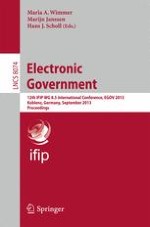2013 | Buch
Electronic Government
12th IFIP WG 8.5 International Conference, EGOV 2013, Koblenz, Germany, September 16-19, 2013. Proceedings
herausgegeben von: Maria A. Wimmer, Marijn Janssen, Hans J. Scholl
Verlag: Springer Berlin Heidelberg
Buchreihe : Lecture Notes in Computer Science
